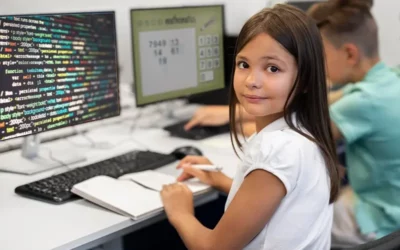Financial literacy is essential for youngsters because it instills lifelong money management skills. It gives students the ability to make informed financial decisions, create appropriate spending habits, and construct a financially secure future. Children benefit from early financial education because it encourages sensible financial decision-making, teaches them the value of saving, and prepares them for a financially independent adulthood. It also gives individuals confidence in handling money, which leads to financial success and stability.
This blog has discussed how financial literacy programs for children give the core information and skills required for responsible money management, putting them on a path to a financially secure and empowered future.
Table of contents
- The Basics of Financial Literacy
- Program 1: Money Smart Kids
- Program 2: Dollars and Sense for Kids
- Program 3: Junior Investors Program
- Program 4: Young Entrepreneurs Academy
- Program 5: Money Matters for Kids
- How to Choose the Right Financial Literacy Program
- The Role of Parents and Guardians
- Common Challenges in Financial Literacy Education
- Implementing Financial Literacy in Schools
- Financial Literacy Resources and Tools
- Conclusion
- Frequency Asked Questions ( FAQs )
The Basics of Financial Literacy

Financial literacy for children includes the knowledge and abilities needed to make wise financial decisions. It teaches youngsters about money concepts such as earning, saving, spending, and sharing. These lessons frequently include educating students about budgeting, recognizing the worth of money, and distinguishing between necessities and wants, often achieved through engaging in financial literacy activities for kids. Early financial literacy provides youngsters with the tools they need to manage their resources properly in the future.
A. Why Start Young?
It is critical to begin financial literacy education at a young age since it instills positive financial habits early on, often referred to as finance for kids. Children are more responsive to learning, and these skills become ingrained in their daily lives. Children can create a strong financial foundation that will serve them well throughout adulthood by starting young.
Program 1: Money Smart Kids

A. Program Overview:
Money Smart Kids is a comprehensive financial literacy program that teaches and empowers children to handle their money. It attempts to create a strong foundation in financial literacy at a young age through interactive teaching and engaging activities.
B. Curriculum Details:
Earning, saving, budgeting, and learning the value of money are among the subjects covered in the program.
Lessons are presented to children through age-appropriate activities for kids, games, and real-life scenarios, making them more accessible and fun.
C. Age Group Suitability:
Money Smart Kids is designed for children aged 5 to 12, with content and teaching methods that are age-appropriate and enjoyable.
D. Success Stories:
Many children who have participated in Money Smart Kids have shown remarkable progress in managing their allowances, setting savings goals, and making informed spending choices. The program’s success stories highlight how early financial education can positively impact young learners, setting them on a path to financial responsibility.
Program 2: Dollars and Sense for Kids

A. Program Overview:
Dollars and Sense for Kids is a cutting-edge financial literacy program that teaches youngsters real money management skills. It focuses on hands-on learning and real-world application to help students gain a thorough understanding of financial topics.
B. Curriculum Details:
Budgeting, saving, investing, and understanding the financial market are among the subjects covered in the program. It uses interactive workshops, simulations, and age-appropriate materials to help children understand financial concepts.
C. Age Group Suitability:
Dollars and Sense for Kids is aimed at children aged 10 to 16, and the content is tailored to their cognitive development and needs, resulting in a more meaningful learning experience.
D. Success Stories:
The program has witnessed numerous success stories, with children demonstrating improved money management skills, responsible spending habits, and an enhanced understanding of financial markets. These success stories, highlighting the positive impacts of money management for kids, underscore the program’s effectiveness in empowering young learners to become financially savvy individuals.
Program 3: Junior Investors Program

A. Program Overview:
The Junior Investors Program is tailored for young individuals seeking to develop a foundational understanding of investing, financial markets, and wealth creation. This program combines education and practical experience to nurture the investment skills of tomorrow’s financial leaders.
B. Curriculum Details:
The curriculum includes modules on stock market basics, asset allocation, and risk management. Participants engage in virtual trading simulations and analyze real-world investment scenarios, often using fun games for kids, gaining valuable insights into financial decision-making.
C. Age Group Suitability:
The Junior Investors Program is ideally designed for teenagers aged 14 to 18, recognizing their cognitive development and capacity for grasping investment concepts.
D. Success Stories:
Graduates of the Junior Investors Program have exhibited enhanced financial literacy, prudent investment decisions, and a passion for wealth creation.
Success stories underline the program’s effectiveness in equipping the next generation with vital financial skills and investment acumen.
Program 4: Young Entrepreneurs Academy
A. Program Overview:
The Young Entrepreneurs Academy is a dynamic initiative that encourages children and adolescents to develop entrepreneurial abilities, supporting their learning money for kids. It enables young people to create, grow, and launch their own businesses. Participants get firsthand knowledge of business operations, marketing, and financial management through hands-on experience, equipping them with valuable skills for a future in entrepreneurship and financial responsibility.
B. Curriculum Details:
The curriculum of the program includes entrepreneurial basics, company planning, market research, and financial literacy. Participants are mentored through the process of forming their startups as well as learning about finance, marketing, and growth strategies.
C. Age Group Suitability:
The Young Entrepreneurs Academy is ideal for teenagers aged 12 to 18, with a curriculum that is customized to their cognitive development.
D. Success Stories:
Graduates of the program have initiated a range of successful businesses, from e-commerce ventures to local service providers. These achievements underscore the program’s effectiveness in nurturing the entrepreneurial spirit and equipping young individuals with the skills to become future business leaders.
Program 5: Money Matters for Kids
A. Program Overview:
Money Matters for Kids is a comprehensive financial literacy program designed to impart essential money management skills to children.
It emphasizes practical knowledge and hands-on experience to ensure financial competence from an early age.
B. Curriculum Details:
The program covers key financial topics, including saving, budgeting, investing, and understanding financial institutions. It employs real-life simulations and age-appropriate resources to facilitate effective learning.
C. Age Group Suitability:
Money Matters for Kids is tailored for children aged 8 to 14, ensuring that the curriculum is both age-relevant and engaging.
D. Success Stories:
Money Matters for Kids has witnessed numerous success stories, with children demonstrating improved money management skills, responsible spending habits, and a solid understanding of financial concepts. These success stories, which include stories for kids, underscore the program’s effectiveness in empowering young learners to become financially savvy individuals.
How to Choose the Right Financial Literacy Program
Selecting the ideal financial literacy program involves several key considerations. Firstly, assess the program’s curriculum, ensuring it covers age-appropriate topics. Verify the qualifications of instructors and the program’s reputation. Look for interactive elements that engage learners, and check for materials that align with your child’s learning style. Cost and accessibility should also be factored in. Choose a program that resonates with your child’s needs and learning preferences while fostering financial empowerment.
The Role of Parents and Guardians

Parents and guardians play a pivotal role in nurturing financial literacy. They can kickstart financial conversations, lead by example, and provide practical money management opportunities for children. By instilling financial values and offering guidance on saving, spending, and responsible financial decision-making, parents and guardians equip their children with essential life skills. Their involvement and open dialogue serve as a strong foundation for a child’s financial journey, helping them become financially responsible adults.
Common Challenges in Financial Literacy Education
Financial literacy education faces several common hurdles. Insufficient resources and standardized curricula often limit program effectiveness. A lack of qualified instructors can hinder quality teaching. Engaging young learners and maintaining their interest in complex financial topics, as seen in financial education for kids, poses a challenge. Overcoming these challenges requires investment in resources, training for educators, and the development of innovative, interactive teaching methods to make financial literacy education more engaging and accessible to students.
Implementing Financial Literacy in Schools

Integrating financial literacy into school curricula is crucial for equipping students with essential life skills. Schools play a pivotal role in fostering a generation of financially responsible individuals who can navigate the complexities of the modern financial landscape with confidence and competence. Developing and implementing effective programs for financial literacy for students is an investment in their future, providing them with the knowledge and tools needed to make informed financial decisions from an early age.
Financial Literacy Resources and Tools
A. Books, Apps, and Websites:
- Books: Consider reading “The Millionaire Next Door” by Thomas J. Stanley for insights into wealth-building habits or “Your Money or Your Life” by Vicki Robin for personal finance transformation. These books for kids, along with their simplified versions, can serve as excellent resources for introducing financial literacy concepts in a comprehensible and engaging way to help them develop strong financial foundations from an early age.
- Apps: Apps like Mint, YNAB (You Need a Budget), and Acorns offer budgeting, expense tracking, and investing tools at your fingertips.
- Websites: Explore financial education websites like Investopedia, NerdWallet, and The Balance for articles, guides, and calculators.
B. Supplementary Learning Materials:
Supplementary learning materials, including online courses, podcasts, and workshops, provide in-depth financial education. Options like Khan Academy, and Coursera, and financial podcasts like “The Dave Ramsey Show” can enhance your financial knowledge and skills, helping you make informed decisions and achieve your financial goals. Early childhood learning also benefits from these resources, as they offer accessible platforms to teach young children the foundations of financial literacy in a fun and engaging manner.
Conclusion
Financial literacy programs for children are instrumental in providing youngsters with a foundational understanding of money management. By offering interactive, age-appropriate lessons on budgeting, saving, and responsible spending, these programs empower children to make informed financial decisions. The benefits extend beyond individual financial wellness, contributing to a financially savvy and economically stable society while ensuring that the younger generation is well-prepared to navigate the complexities of the financial world and build a secure financial future.
To get your hands on more educational and free resources on coding for kids, robotics for kids, financial education for kids, etc., do check out the BrightCHAMPS Page now!
Frequency Asked Questions ( FAQs )
A1. Introducing financial concepts can start as early as preschool, with age-appropriate activities.
Q2. How can I assess the quality of a financial literacy program?
A2. Assess program quality by checking for qualified instructors, comprehensive content, and positive reviews.
Q3. What are some fun activities to teach kids about money?
A3. Fun money-related activities include games, setting savings goals, and involving kids in budgeting decisions.
Q4. Can financial literacy programs be accessed online?
A4. Yes, many financial literacy programs are accessible online for convenient learning.
Q5. How do I monitor my child’s progress in a financial literacy program?
A5. Monitor your child’s progress by reviewing completed activities, discussing lessons, and tracking their financial decisions.


 We are an army of educators and passionate learners from BrightChamps family, committed to providing free learning resources to kids, parents & students.
We are an army of educators and passionate learners from BrightChamps family, committed to providing free learning resources to kids, parents & students.












